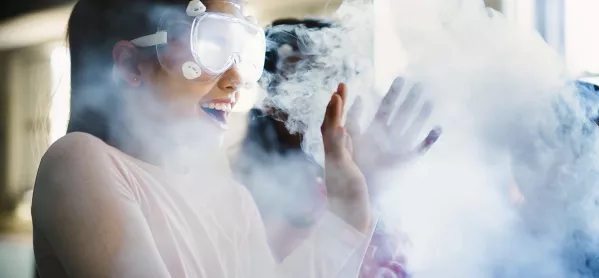Stem: How to persuade girls to aim for the stars

Science teachers are lucky: we get to teach really exciting stuff. That doesn’t mean we should just depend on flashes and bangs; we need to show our students how far science, technology, engineering and maths (Stem) subjects can take them. And that’s the entire universe.
In the UK, girls are more likely to drop Stem subjects than boys. Statistically, many do so after GCSEs, as soon as they have the opportunity. This is particularly true for physics and computing. There are a variety of possible reasons for this but what’s clear is that it’s not that girls aren’t as good at those subjects. Indeed, last summer a higher percentage of girls got a B or better than their male peers in A-level biology, computing, maths and physics.
It’s not that we need to change our lessons just to interest girls. The Institute of Physics has conducted research tracking student choices in schools with interventions including split-class teaching, different approaches and external speakers, and found that the same thing works to engage both boys and girls: good teaching. Following simple suggestions based on evidence from these projects will help everyone, because they reduce the impact of low confidence on performance. The issue is that ignoring these principles puts girls off more, possibly because of the pervasive messages they receive from parents, peers and the media. The danger is that, without careful support, girls who could excel in Stem subjects choose not to study them.
It’s important to refer to inclusive contexts and a variety of careers. This doesn’t mean we can’t use football and motor racing in lessons on forces, but it does suggest we should offer other examples, too. It’s surprising how many textbooks and resources use the same familiar situations, which often reinforce outdated stereotypes. It’s easy for students to get the idea that engineering is just another word for being a mechanic and that the only health professionals are doctors, nurses and pharmacists. That doesn’t mean all girls are put off by boiler suits, obviously, but including a wider range of options shows all students that there could be something they would enjoy in these professional fields.

There is mounting evidence, including that summarised in the 2013 ASPIRES report, which suggests that referring to the social implications of different disciplines and careers (how they affect society, not that they involve talking to people) has a big effect on the interest and progression of all students, but particularly girls. It’s about teaching - with examples from a variety of contexts - that you don’t have to be a stereotypical scientist to use science in your work. And this is your chance to use really big ideas.
Shattering Stem gender stereotypes
Biodiversity and potential extinctions affect us all. Fuels, fertilisers and plastics are vivid examples of the uses of chemistry. And then there’s space: it is relevant to almost everything, from the GPS in your students’ phones to questions about Earth’s place in the universe
You’ll need to be prepared for some big questions, but these will be fuelled by genuine curiosity. Take advantage of the opportunity to discuss scientific models and analogies. These explicit explanations won’t hold back the confident students, but will be a real boost to those who lack faith in their own ability, particularly girls. Discussions about how we imagine the solar system demonstrate how working scientifically has not always been easy or safe: just ask Galileo!
Discussing the needs of astronauts, whether on the International Space Station or a hypothetical future base on the Moon or Mars, allows us to explore many other scientific ideas. Food and nutrition, ecosystems, electricity generation, carbon and water cycles, pathogens; all vital considerations if we want to keep them alive.
And each step into space gave us solutions to life here on Earth, too, from miniaturised electronics including digital cameras, to improved solar cells and even memory-foam mattresses. If these don’t impress your students, remind them that mobile phones rely on satellites both for signals and GPS. These contexts make the relevance of science and engineering to their lives more obvious, something which has been shown to particularly motivate girls.
The Airbus Foundation Discovery Space in Hertfordshire has tried some of these approaches, for example with students from North London schools. It is looking to develop its popular workshops into more sustained programmes, using “stealth learning”. The team who lead the sessions - which vary from bath bombs to paint rockets - are all active engineers with a dual role working with visiting students. We know that role models are not enough by themselves, which is why it is encouraging when students encounter female professionals as participants, not just pictures on posters. They say the challenge is to ensure that students with low levels of interest in science, particularly girls, can attend the workshops, and it is for this reason that travel to some events has been covered by sponsorship.
In the UK, the reduced participation of girls in Stem subjects and careers means missed opportunities - for them and for society as a whole. Space combines the inspiration and helpful contexts which might help them to see that science could be for them after all.
Ian Horsewell is a former science teacher and is now part of the education team at the Institute of Physics. He blogs at http://teachingofscience.wordpress.com and tweets as @teachingofsci
